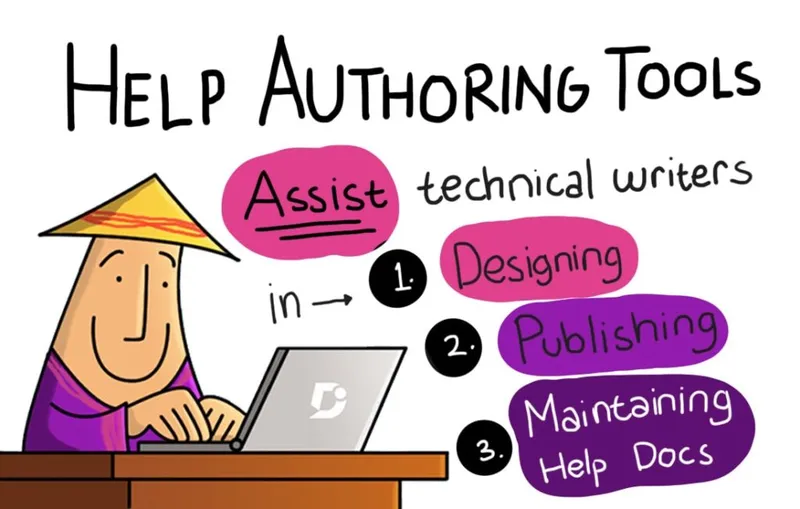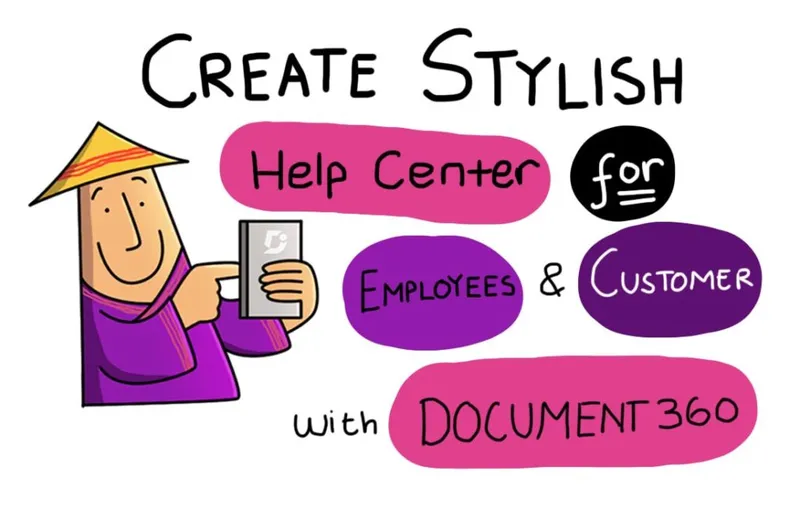

The Most Popular Help Authoring Tools Compared
Help Authoring Tools are an important category of software since they allow you to produce and maintain help content for your business. They are typically robust with a wide range of functionality that allows for content management on a large scale.

This may be the first time you’re hearing about HATs, so we’re going to compare some of the most popular solutions for you.
The current market for HATs is dominated by a few key players, although more and more solutions are becoming available. Some of the most popular are Adobe RoboHelp, Madcap Flare and HelpNDoc.
You would traditionally find HATs like these being used by enterprise companies. These solutions are geared towards helping teams write their documentation collaboratively, and publish them on a variety of mediums. Formats include web pages, PDFs, Word documents, printed manuals, and printed booklets. HATs usually have good support for images, which are often crucial in product manuals.
Producing content for multiple mediums is known as single source publishing. Single source publishing can be tricky to get right because web-based and print-based mediums have different formatting needs. For example, to print a manual you must have support for indexing – accurate references from the index pointing to specific pages in your documentation. This can be hard to achieve as a project evolves and undergoes many changes.
Document360 is a web-based alternative to some of the more expensive desktop solutions, and the fact that it’s SaaS (Software as a Service) means you can scale your documentation strategy quickly. It produces help content only for a documentation website, and excludes printed manuals.
We’ll go into some of the top solutions now and explain when you might use them.
Madcap Flare
Madcap Flare is possibly the most popular Help Authoring Tool out there. There’s even a yearly conference surrounding the product called MadWorld.
The industries using MadCap Flare the most are the technology, healthcare, manufacturing and education industries. You can use this software to produce technical documentation tagged with the markup language XML, which keeps the documentation structure separate from its final formatting destination. This allows you to easily reuse your content across different platforms.
Madcap Flare comes in at $1,648.00 for a 12-month license and it’s installed locally on your desktop. There is another version of the software called Madcap Central, a cloud-based Help Authoring Tool that is meant to be paired with the desktop version.
This type of tool is aimed at enterprise users with a lot of documentation to manage, and potentially a lot of legacy documentation to contend with. The content you produce needs to be reused by many different people over a long period of time, so the software helps you keep track of these individual content modules.
The focus in this software is on managing content within the Madcap Flare database, and marking it up for reuse in any number of different formats. The markup does not change the body of the content, but defines the way in which it should be presented.
Madcap Flare is useful for enterprise companies that need to comply with regulations to produce large amounts of documentation, and companies that have dedicated technical writers who can be trained to use the software.
Flare is a good option for single sourcing documentation – and particularly print documentation. On the down side, the learning curve is very steep, and not accessible to your average or casual user. The price may also exclude many small to medium-sized businesses.
Adobe RoboHelp
Adobe offers a Help Authoring Tool called RoboHelp and it is the main rival to Madcap Flare. It costs $1379.24 for organisations to purchase the full yearly licence.
Adobe RoboHelp creates all content files in XHTML, so if you use both tools the files will need to be converted from XML to XHTML using their converter.
RoboHelp calls its help content units ‘topics’, which you define as a single unit of content. This could be a word, sentence, paragraph, or entire page. You then use your topics as the basis for producing specially formatted, reusable help content – known as topic-based authoring.
RoboHelp is aimed more towards producing responsive documentation websites than it is towards printed manuals. It includes template designs that allow you to produce stylish looking sites very quickly, since it auto-generates the code for the web pages. RoboHelp can support multiple documentation sites, but you are responsible for hosting the servers and websites.
While RoboHelp does support printed content, this is more of an add-on function than a central feature. If your focus leans towards print, Madcap Flare is a better choice than RoboHelp.
On the other hand, if all you want is a single documentation website, RoboHelp may not be the best option. A documentation solution for creating a responsive, modern website like Document360 is more likely to fulfil your needs.
HelpNDoc
One of the main criticisms of the two major Help Authoring Tools RoboHelp and Madcap Flare is that it’s hard for new users to learn the interface. These products must walk a thin line between keeping the interface consistent on each release for long-time users, and welcoming users who have never used this type of software before.
HelpNDoc has entered the market as a slightly simpler Help Authoring Tool that cuts out much of the extensive functionality you get with RoboHelp and Madcap Flare. It’s as simple to use as a basic Windows interface and Microsoft Word, and it’s published by IBE Software.
HelpNDoc comes as a desktop installation, and costs $283.96 for a single license with a year’s worth of support and updates included. The license is related to each version, so when a new version is released you will need to purchase HelpNDoc again to receive updates and support.
You can use the software to produce HTML and CHM documents, PDF and Word files, EPUB, and also responsive mobile sites. HelpNDoc supports both online and print. You can also export your content to your chosen format, such as PDF, by clicking a single button.
The software includes features such as the creation of variables, which you use to define a reusable piece of content. If your content needs updating, you only have to update it once using the variable. For example, you can update the same image used in multiple instances by updating it once in the library.
On the down side, you can only use HelpNDoc on Windows, so if you use Linux or Mac OS then you can’t run this software.
ClickHelp
ClickHelp is a web-based Help Authoring Tool and it’s offered at $2520 for the pro version, but three authors are included with your plan. Even though ClickHelp is browser-based, you can still produce quality print manuals with this solution.
The software includes capabilities for publishing contextual help, which means your content can pop up within an interface to provide support during the user experience. The advantage of ClickHelp is a sleek backend User Interface much more in keeping with modern software solutions. You can output to a number of formats, including HTML5, CHM, PDF and EPUB.
Like HelpNDoc, ClickHelp is quick to get up and running. It has a focus on scaling in that you can easily move between their different plans as your company grows. One of the biggest advantages of SaaS solutions (compared to desktop installations) is their accessibility for smaller businesses expecting rapid growth.
It’s important to note that in ClickHelp you’re limited on the number of topics you can create to 2000, so if you anticipate having a lot of help content then this solution may not be for you. ClickHelp is aimed at small to mid-sized companies rather than the enterprise.
Document360

Document360 is our own software which can be used in place of a Help Authoring Tool. It starts at $49 per month which works out at $588 per year.
Document360 has been built to enable you to create a stylish help center aimed at either internal staff or external stakeholders. The publishing system has been designed to allow you to quickly create web pages, and collaborate with a technical team using peer review and publishing.
Document360 has very little learning curve. Create content for web pages that is styled inline with Markdown using our editor, and easily reorder your content and categories with our drag-and-drop interface.
Document360 is for web-based help content, so it’s not a tool you would use for printed manuals. It cuts out all the unnecessary features from your typical Help Authoring Tools so you can focus on creating a self-service portal. Document360 has been designed for the SaaS market, with teams that iterate and scale rapidly.
One of the major differences between Document360 and other Help Authoring Tools is the ease with which you can create a modern responsive website filled with quality content. There is less focus on content reuse across platforms, and more emphasis on presentation and web usability. Publish directly to the web with our easy-to-use Content Management System (CMS) and in-built CSS templates.
What to look for
Help Authoring Tools (HATs) are specialist software solutions that target technical writers and developers with years of training. The market is now expanding to include solutions that are dedicated to creating online self-service portals. While there is a lot of crossover between the different tools, it’s important to decide early which solution best fits your needs and why.
Think about how your documentation process is going to work before settling on a Help Authoring Tool. Your solution should have the capability to edit text, data, or code, provide an input for source text and an output for help files, and capabilities for adding indexes, content tables, or images.
Even though tools like Madcap Flare and RoboHelp are impressive, make sure you’re not paying for lots of functionality you don’t need. They have been developed for a large user base and contain lots of features for many use cases, making their interfaces harder to use.
While these are trusted brand names, lesser-known but excellent quality solutions like Document360 may be perfect for your organisation’s documentation needs.
Document360 is a tool you can learn to use straight away and allows you to create content in Markdown. Explore it's benefits






![Top 10 Cheap Indian Press Release Distribution Services [Updated]](https://images.yourstory.com/cs/1/b3c72b9bab5e11e88691f70342131e20/LOGO-DESIGN-PR-INDIA-WIRE-03-1595693999405.png?mode=crop&crop=faces&ar=1%3A1&format=auto&w=1920&q=75)
